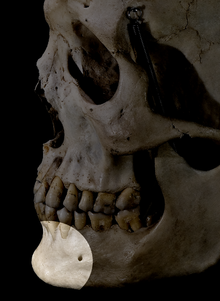Evolutionary Origins and Development of the Chin
- The human chin evolved as a distinguishing feature of Homo sapiens.
- Its origin and function during feeding and speech are debated.
- Some theories suggest the chin evolved to resist masticatory stresses, while others argue it indicates better force resistance capacity.
- Recent research suggests the chin evolved through reduction in size and change in shape of the face.
- The development of the chin begins during prenatal period and continues through bone remodeling processes in the early postnatal period.
- Forward displacement of the hyoid bone and coordinated bone growth and modeling processes shape the chin.
- The evolution of the chin is not solely driven by mechanical forces such as chewing.
Functional Morphology and Importance of the Chin
- The chin plays a role in stabilizing the lower jaw during chewing and speaking.
- It helps distribute forces evenly across the jaw and prevents fractures.
- The shape and size of the chin can vary among individuals and populations.
- Understanding the functional morphology of the chin provides insights into its evolutionary significance.
- The chin has cultural and aesthetic significance, often associated with attractiveness and beauty standards.
- Chin augmentation and reduction surgeries are common cosmetic procedures.
- The presence or absence of a prominent chin can affect facial proportions and overall facial harmony.
- The chin can be used as a diagnostic feature in forensic anthropology and facial recognition technology.
Abnormalities and Variations of the Chin
- Cleft chin refers to a dimple on the chin caused by incomplete fusion of the jaw bone during development.
- Genetic and environmental factors influence the development of cleft chin.
- Double chin can be caused by sagging subcutaneous fat in overweight individuals.
- Surgical intervention may be necessary to address double chin caused by bony deficiency or jaw muscle shortening.
- Abnormalities in chin development, such as cleft chin, can be inherited or caused by genetic mutations.
- Genetic marker rs11684042 on chromosome 2 may be associated with cleft chin.
Controversies and Unsolved Mysteries of the Chin
- The evolutionary origins and functional significance of the chin are still debated.
- Some researchers propose that the chin is a byproduct of other facial changes, rather than an adaptation.
- The genetic basis of chin development and variation is not fully understood.
- The role of mechanical forces in shaping the chin is still a subject of investigation.
- Continued research is needed to understand the significance of the chin in human evolution.
- The chin may provide unexpected insights into what it means to be human.
Related Concepts and Topics
- Chin augmentation (genioplasty) is a surgical procedure to enhance the appearance of the chin.
- Masseter is a muscle involved in chewing.
- Mastication refers to the process of chewing food.
- Otofacial syndrome is a genetic disorder affecting the development of the ears and face.
- Ptosis (chin) refers to drooping of the chin.
- The references cited provide further information on the topic.
The chin is the forward pointed part of the anterior mandible (mental region) below the lower lip. A fully developed human skull has a chin of between 0.7 cm and 1.1 cm.
